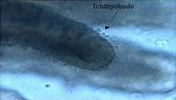Prokinetoplastina
Julius Lukes


This tree diagram shows the relationships between several groups of organisms.
The root of the current tree connects the organisms featured in this tree to their containing group and the rest of the Tree of Life. The basal branching point in the tree represents the ancestor of the other groups in the tree. This ancestor diversified over time into several descendent subgroups, which are represented as internal nodes and terminal taxa to the right.

You can click on the root to travel down the Tree of Life all the way to the root of all Life, and you can click on the names of descendent subgroups to travel up the Tree of Life all the way to individual species.
For more information on ToL tree formatting, please see Interpreting the Tree or Classification. To learn more about phylogenetic trees, please visit our Phylogenetic Biology pages.
close boxRelationships after Simpson et al. (2006).
Introduction
The Prokinetoplastina are a group composed primarily of Ichthyobodo and Perkinsiella, which has been defined only recently on the basis of molecular phylogeny, in particular the spliced leader and SSU RNA genes (Moreira et al., 2004; Simpson et al., 2006). Since the two known representatives are morphologically very different from each other, it is impossible to find features characteristic for this earliest branch within Kinetoplastida. Perkinsiella amoebae is an endosymbiont present in a perinuclear position in another protist, an amoebae of the genus Neoparamoeba parasitizing gills of commercial fish (Dykova et al., 2003). Due to its size and localization in the host cell, Perkinsiella can only be visualized by electron microscopy or by a trained eye in stained histological sections.
Ichthyobodo necator (also called Costia necatrix in the older literature) is an ectoparasite of characteristic drop-like shape found on the gills and skin of freshwater and marine fish. It may cause heavy infections leading to irritation and eventually lethal bacterial infections. With one of its two flagella, Ichthyobodo attaches itself to the host cell.
Several environmental 18S rRNA sequences amplified directly from samples collected close to the deep-sea hydrothermal vents in the Mid-Atlantic Ridge are also tentatively included to Prokinetoplastina.
References
Simpson A.G.B., J.R. Stevens and J. Lukeš. 2006. The evolution and diversity of kinetoplastid flagellates. Trends Parasitol. 22: 168-174.
Title Illustrations

| Scientific Name | Ichthyobodo necator and Cyprinus carpio |
|---|---|
| Comments | Ichthyobodo necator parasites in the gill tissue of common carp. |
| Copyright |
©
Julius Lukes

|
About This Page
This page is being developed as part of the Tree of Life Web Project Protist Diversity Workshop, co-sponsored by the Canadian Institute for Advanced Research (CIFAR) program in Integrated Microbial Biodiversity and the Tula Foundation.
Julius Lukes

University of South Bohemia in Ceske Budejovice, Czech Republic
Correspondence regarding this page should be directed to Julius Lukes at
jula@paru.cas.cz
Page copyright © 2009 Julius Lukes
All Rights Reserved.
- First online 02 January 2009
- Content changed 02 January 2009
Citing this page:
Lukes, Julius. 2009. Prokinetoplastina. Version 02 January 2009 (under construction). http://tolweb.org/Prokinetoplastina/125663/2009.01.02 in The Tree of Life Web Project, http://tolweb.org/







 Go to quick links
Go to quick search
Go to navigation for this section of the ToL site
Go to detailed links for the ToL site
Go to quick links
Go to quick search
Go to navigation for this section of the ToL site
Go to detailed links for the ToL site